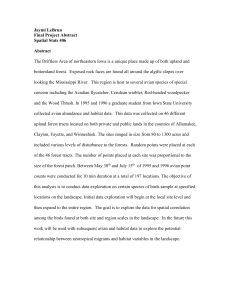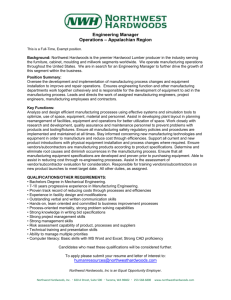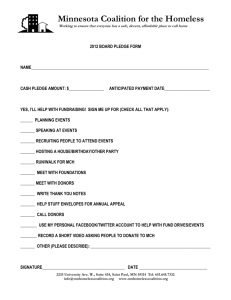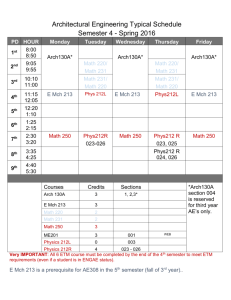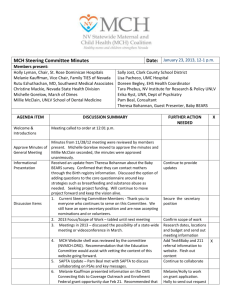Managing Mixed Conifer-Hardwood Habitat for Birds in the Sierra Nevada
advertisement
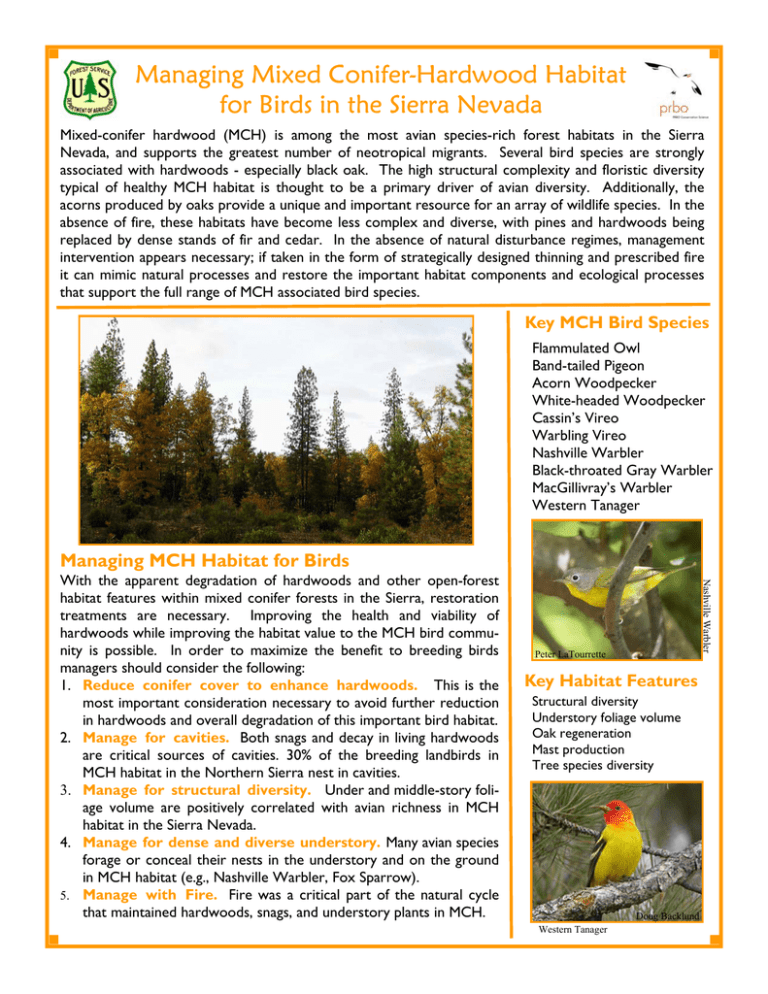
Managing Mixed Conifer-Hardwood Habitat for Birds in the Sierra Nevada Mixed-conifer hardwood (MCH) is among the most avian species-rich forest habitats in the Sierra Nevada, and supports the greatest number of neotropical migrants. Several bird species are strongly associated with hardwoods - especially black oak. The high structural complexity and floristic diversity typical of healthy MCH habitat is thought to be a primary driver of avian diversity. Additionally, the acorns produced by oaks provide a unique and important resource for an array of wildlife species. In the absence of fire, these habitats have become less complex and diverse, with pines and hardwoods being replaced by dense stands of fir and cedar. In the absence of natural disturbance regimes, management intervention appears necessary; if taken in the form of strategically designed thinning and prescribed fire it can mimic natural processes and restore the important habitat components and ecological processes that support the full range of MCH associated bird species. Key MCH Bird Species Flammulated Owl Band-tailed Pigeon Acorn Woodpecker White-headed Woodpecker Cassin’s Vireo Warbling Vireo Nashville Warbler Black-throated Gray Warbler MacGillivray’s Warbler Western Tanager Managing MCH Habitat for Birds Nashville Warbler With the apparent degradation of hardwoods and other open-forest habitat features within mixed conifer forests in the Sierra, restoration treatments are necessary. Improving the health and viability of hardwoods while improving the habitat value to the MCH bird community is possible. In order to maximize the benefit to breeding birds managers should consider the following: 1. Reduce conifer cover to enhance hardwoods. This is the most important consideration necessary to avoid further reduction in hardwoods and overall degradation of this important bird habitat. 2. Manage for cavities. Both snags and decay in living hardwoods are critical sources of cavities. 30% of the breeding landbirds in MCH habitat in the Northern Sierra nest in cavities. 3. Manage for structural diversity. Under and middle-story foliage volume are positively correlated with avian richness in MCH habitat in the Sierra Nevada. 4. Manage for dense and diverse understory. Many avian species forage or conceal their nests in the understory and on the ground in MCH habitat (e.g., Nashville Warbler, Fox Sparrow). 5. Manage with Fire. Fire was a critical part of the natural cycle that maintained hardwoods, snags, and understory plants in MCH. Peter LaTourrette Key Habitat Features Structural diversity Understory foliage volume Oak regeneration Mast production Tree species diversity Doug Backlund Western Tanager Adaptive Management A vital part of effective land management is developing a program of monitoring and adaptive feedback. As hardwood restoration treatments are a new practice in the Sierra Nevada, monitoring the response of the ecosystem and feeding information back into future treatments will result in the greatest benefit to wildlife. Bird monitoring is an ideal tool for providing cost-effective feedback on a whole community of organisms. Mimicking the Role of Fire 10 5 0 MCH Avian Focal Species Abundance 15 Fire suppression, even aged management, and likely climate change have resulted in expansion of densely stocked white fir dominated forests in the mixed conifer zone. Band-tailed Pigeon Due to their limited maximum height and shade intolerance, hardwoods and shrubs are dependent on disturbance to create suitable conditions for growth and regeneration. Throughout the mixed conifer zone in the Northern Sierra, conifer encroachment is prevalent. Often “skeletons” are all that remain of shrubs and hardwoods in dense mid-successional fir dominated stands. MCH avian focal species abundance is negatively associated with White Fir cover in the Lassen National Forest (see figure). Thinning in association with prescribed burns may mimic the conditions created by natural fires invigorating hardwood, shrub, and herbaceous vegetation components of MCH habitat. 0 20 40 60 Forest Structure and Birds White Fir Foliage volume and structural diversity are key predictors of avian species richness in MCH forest. A mosaic of canopy covers dominated by pine and hardwoods - likely typical under a natural fire regime can support vegetation structure from the forest floor to the canopy. Treatments to enhance this forest type should focus on applying an uneven-aged mosaic design with dense patches of pine-dominated conifers, semi-open hardwood areas, and open patches with vigorous shrub and herbaceous vegetation. Hardwoods in a Conifer Sea In the Sierra Nevada hardwoods represent a small percent of the total forested habitat and are limited in their extent. However, hardwoods are an important wildlife resource in this “conifer sea.” Many bird species reach their greatest abundance in conifer-hardwood habitat, several of which are exclusively tied to hardwoods, including Nashville Warbler, Band-tailed Pigeon, and Acorn Woodpecker. Many insect-gleaning birds choose to forage or nest in hardwoods over conifers, including Warbling and Cassin’s Vireos and Black-throated Gray and Nashville Warblers. Resources ♦ ♦ ♦ ♦ ♦ Coniferous Forest and Sierra Nevada Bird Conservation Plans www.prbo.org/calpif/ Lassen National Forest Biologists mrwilliams@fs.fed.us crobbins@fs.fed.us Pacific Southwest Research Station US Forest Service www.fs.fed.us/psw/programs/snrc/ PRBO Conservation Science Sierra Nevada Program rburnett@prbo.org Birds and Burn Network www.rmrs.nau.edu/lab/4251/birdsnburns/ Funding Provided by: The National Fire Plan and USDA Forest Service: Region 5, Lassen National Forest, & HFQLG Monitoring Funds
